Middle-Earth: Shadow of Mordor – Preview
by Edward
|
With the final instalment of The Hobbit trilogy arriving later this year, I doubt I would have been alone in thinking that would be the last we’d see of the Middle Earth universe for the time being. After all, what else is there left to adapt? The Simarillion? Most people I know have never heard of it, let alone read it. Yet, despite some excessively-long books, there’s still plenty we don’t know about the history of that world.
 Cue Monolith Studios and Middle-Earth: Shadow of Mordor, which aims not only to immerse players in the land of orcs and superfluous chapters once again, but to bridge the gap between the events of The Hobbit and The Lord of the Rings with a wholly new story of its own. Players are thrust into the role of Talion, a Gondor Ranger slain by the armies of Sauron when guarding the Black Gate of Mordor. Rather than join the leagues of barely-fleshed-out characters who’ve died in the Tolkienverse, he awakes to find himself alive, but imbued with the power of the Wraiths. Thus, Talion decides to travel into Mordor itself and exact his revenge.
Cue Monolith Studios and Middle-Earth: Shadow of Mordor, which aims not only to immerse players in the land of orcs and superfluous chapters once again, but to bridge the gap between the events of The Hobbit and The Lord of the Rings with a wholly new story of its own. Players are thrust into the role of Talion, a Gondor Ranger slain by the armies of Sauron when guarding the Black Gate of Mordor. Rather than join the leagues of barely-fleshed-out characters who’ve died in the Tolkienverse, he awakes to find himself alive, but imbued with the power of the Wraiths. Thus, Talion decides to travel into Mordor itself and exact his revenge.
Taking place in the middle of the story, the demo began with our hero being given the task of hunting down Sauron’s best War Chiefs and taking them out, one by one. The developers were keen to emphasise that no two playthroughs would be exactly the same, and showed us a screen full of everyone that we could potentially come up against in this chapter to demonstrate why. Rather than just one or two major players, there were five separate War Chiefs to dispatch, along with around fifteen significant underlings, most of whom we’d definitely be squaring up against in some way or another to finish this particular task.
From this selection, players can also get a more in-depth description of each target, complete with their names, personality type, general location and what method is needed in order to draw them out. Initially, I thought that outright telling the player what they needed to do felt rather cheap, until I actually read the descriptions and realised that each were specific enough that there would be no way of knowing what to do, otherwise. In this instance, one method required stalking a particular underling and targeting them until they squeal their master’s name, while another needed Talion to start a fight and then intentionally hide himself until the War Chief arrived and specifically called him out.
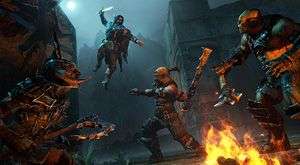 Further complicating matters is the fact that each notable enemy comes with their own unique set of perks, strengths and weaknesses, ensuring that you have to adopt a different set of tactics for every one. While one target might be immune to ranged attacks, another might be immune to stealth attacks instead, while another still could have the ability to run faster when fleeing from battle, or can call extra bodyguards into the fray. Learning these traits and adapting your strategy to fit will be all-important if you don’t want to come a cropper.
Further complicating matters is the fact that each notable enemy comes with their own unique set of perks, strengths and weaknesses, ensuring that you have to adopt a different set of tactics for every one. While one target might be immune to ranged attacks, another might be immune to stealth attacks instead, while another still could have the ability to run faster when fleeing from battle, or can call extra bodyguards into the fray. Learning these traits and adapting your strategy to fit will be all-important if you don’t want to come a cropper.
While the target was selected and Talion went about his task, it was hard not to get caught up in how stunning the land of Mordor looks. Rather than the desolate, war-torn nation you remember, it’s a beautiful land full of stunning vistas and massive, grassy environments to roam about in. As Sauron is preparing his armies and has yet to devastate the region, it’s hard not to feel a slight ache of sadness when you remember what Mordor will become.
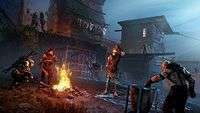 |
 |
 |
 |
 |
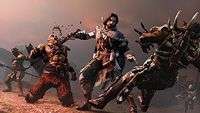 |
As Talion makes his way towards his first target, one of his otherworldly abilities is briefly shown off as he enters the Wraith world, throwing the land into shadow while highlighting people and animals in a ghostly hue. For those who’ve seen the films, it’s much like the world as Frodo sees it whenever he wears the One Ring. In practice, it’ll be useful to look for enemies or creatures in the distance, but you won’t be able to use it all the time like you could Batman’s Detective Vision in the Arkham series. While still in this realm, Talion spots an animal in the distance, teleports onto its back and uses his powers to placate it, turning it into a rideable mount. If you don’t fancy riding around the luscious landscapes of Mordor, then you can also fast-travel once you’ve unlocked the specific beacons on the map.
 The combat is a great deal gorier than you’d initially expect it to be, as black blood occasionally splashes about while enemies are routinely stabbed, slashed, and brutally beheaded. Fighting looks very fast and frantic, but it also seems a bit light at the moment. It might not be the case come release, but it lacks real impact and seems a bit too easy to lop somebody’s head off, regardless of whether you’re fighting a group of enemies or taking them on one at a time.
The combat is a great deal gorier than you’d initially expect it to be, as black blood occasionally splashes about while enemies are routinely stabbed, slashed, and brutally beheaded. Fighting looks very fast and frantic, but it also seems a bit light at the moment. It might not be the case come release, but it lacks real impact and seems a bit too easy to lop somebody’s head off, regardless of whether you’re fighting a group of enemies or taking them on one at a time.
My worries were allayed, slightly, when Talion came up against his first major minion, only to die in what was, otherwise, a close-knit fight. Upon his death, he respawned at a fast-travel location and day switched to night, where we were told different monsters would be prowling the plains. If you are in a fight with a named opponent and they defeat you, then something altogether more interesting happens.
Not only was the screen of enemies full of different people that Talion needed to dispatch, but there’s also a deep political system at play. One enemy might want to replace another, but be too low a rank to oppose him, someone might be planning a coup to power and need only the slightest provocation, or they may just plain hate each other and want to settle their own differences. When our hero lost his previous skirmish, the house of cards started to wobble ferociously.
 As our opponent won, his ranking increased, allowing him to feel confident enough to duel with someone he hated, providing the perfect opportunity to take revenge. If Talion attends the fight, he can either stand idly by and see who takes the other out, or he can get directly involved in the action and make sure the battle goes the way he wants. In this case, our hero’s seeking revenge and swiftly dispatches his most recent killer, prompting the duel’s other participant to turn tail and flee. Ever the violent man, Talion gives chase and pins him down, which spawns a selection of actions he can now perform.
As our opponent won, his ranking increased, allowing him to feel confident enough to duel with someone he hated, providing the perfect opportunity to take revenge. If Talion attends the fight, he can either stand idly by and see who takes the other out, or he can get directly involved in the action and make sure the battle goes the way he wants. In this case, our hero’s seeking revenge and swiftly dispatches his most recent killer, prompting the duel’s other participant to turn tail and flee. Ever the violent man, Talion gives chase and pins him down, which spawns a selection of actions he can now perform.
The first of these is to put his opponent out of their misery and kill them outright, while a second is to let them go free and live to fight another day. A variation of this comes in the third option, where the foe is not only let free, but he’s instructed to send a warning to his master, letting him know that Talion is coming for him. Doing this makes the ensuing fight more difficult as the foe then ups his security, but it also increases any potential reward that arises as a result of killing him. Finally, there’s the ability to possess the foe using Wraith powers, so that he can be manipulated into doing our hero’s bidding. In this case, he’s persuaded to betray his boss and challenge him for the position of War Chief.
 |
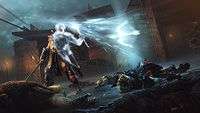 |
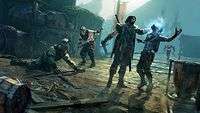 |
 |
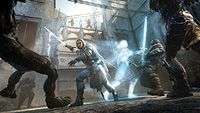 |
 |
After selecting the final option and letting his new friend escape, Talion fast-travelled to nearby the War Chief, who was giving a rousing speech to his brethren, only to be attacked by our recently-possessed chum. Using the new-found chaos as a distraction, our hero scaled the nearby scenery and leaped off a building onto an unsuspecting enemy. A full-on fight promptly broke out at this point, with twenty orcs fighting both Talion and each other in a battle for ultimate supremacy. Unfortunately, time ran out at this point, but even if the War Chief was dispatched, there would still be another four to go before the chapter was done.
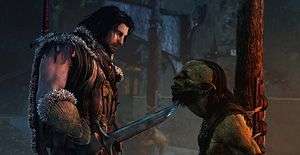 Before seeing Middle-Earth: Shadow of Mordor, my expectations were, admittedly, quite low. I didn’t expect anything other than a competent return to the Tolkienverse that was flawed but fun, if ultimately forgettable. Instead, what I saw was a beautiful open-world adventure with some incredibly deep mechanics and systems at play that reward the player for exploration and experimentation, and which genuinely feels like no two playthroughs would end up being exactly the same.
Before seeing Middle-Earth: Shadow of Mordor, my expectations were, admittedly, quite low. I didn’t expect anything other than a competent return to the Tolkienverse that was flawed but fun, if ultimately forgettable. Instead, what I saw was a beautiful open-world adventure with some incredibly deep mechanics and systems at play that reward the player for exploration and experimentation, and which genuinely feels like no two playthroughs would end up being exactly the same.
Admittedly, the soundtrack could potentially start to grate after a while, with its constant need to be as ‘epic’ as its Lord of the Rings counterpart, and the in-situ cut-scene that plays out whenever you’re introduced to one of the named enemies or face off against them started getting on my tits by the end of the demo. Even with those minor flaws in mind, it looks leaps and bounds above what you’d initially expect, and has easily become one of the ‘must-play’ titles of the year.
Last five articles by Edward
- Best of 2015: Journey's End: A New Beginning
- Journey's End: A New Beginning
- You Can't Choose Your Happy Ending
- Okay, Let's Fix Comedy In Games - The V-Effekt
- Time Keeps On Smashing Away



















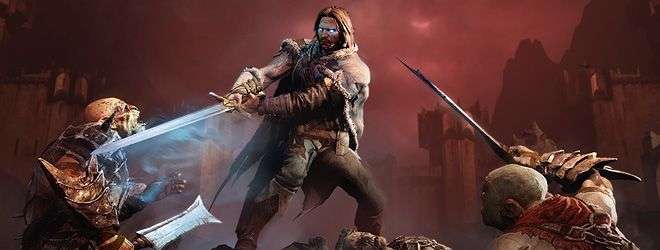





There are no comments, yet.
Why don’t you be the first? Come on, you know you want to!